Summary of Arthur Heygate Mackmurdo
An innovative and socially conscious architect and designer, Arthur Heygate Mackmurdo was a key player in the Arts and Crafts movement and a founding member of the Century Guild, a collective of artists who followed the teachings of William Morris. In the 1880s, he took the concepts and appearances of Arts and Crafts and began incorporating elements of Japanese and Chinese art and a greater fluidity and asymmetry into his designs. Consequently, many of his works from this period are recognized pioneering the Art Nouveau movement. Throughout his career, Mackmurdo maintained an interest in social and economic reform and the preservation of historic buildings. He later retired from the art world and settled in Essex where he became a well-known campaigner on socialist issues and electoral reform, writing pamphlets and a book on a variety of related subjects.
Accomplishments
- Mackmurdo was heavily influenced by William Morris and John Ruskin and through the output of the Century Guild, he helped to disseminate Morris' Arts and Crafts ideas to the wider population. He made Arts and Crafts visible through high-profile exhibitions and work such as the interiors of the famous Savoy Hotel in London and accessible through his commitment to affordable and practical style.
- He pre-empted the Art Nouveau movement by a decade in terms of designs, motifs and his adoption of new technologies. Mackmurdo's work is seminal in the influence it had on later Art Nouveau artists worldwide including Hector Guimard, Victor Horta, and Charles Rennie Mackintosh. He is particularly known for his early use of the whiplash curve which became the most iconic, consistent, and universal of all Art Nouveau motifs.
- Mackmurdo's Socialist beliefs influenced his artistic output, particularly in terms of creating affordable housing that was both functional and aesthetically pleasing and his designs for family housing such as Brooklyn (1883-87) became examples of what could be achieved on a very limited budget with careful and clever planning. He also believed in the importance of community, founding the Essex Rural Community Council which, amongst other functions, created or renewed 112 village halls across Essex, some of which Mackmurdo designed.
The Life of Arthur Heygate Mackmurdo
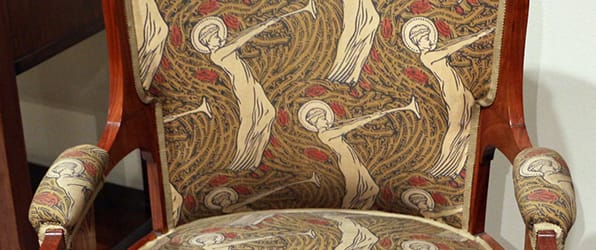
Arthur Heygate Mackmurdo, who called himself "an artist with a scientific training", spent just over a decade leading the Century Guild of artists, whose principles were closely aligned with those of other members of the Arts and Crafts movement, before giving up his artistic and architectural practice altogether in order to focus on social and economic reform.
Important Art by Arthur Heygate Mackmurdo
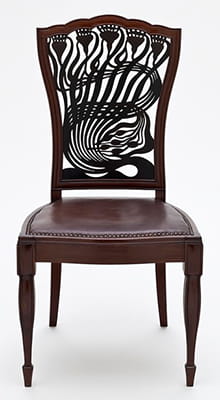
Chair
This elegant mahogany dining chair was one of Mackmurdo's most influential early designs. The legs and seat are conventionally shaped, based on Georgian furniture of the 1780s. The fretwork back, however, is made up of flowing organic forms, reminiscent of seaweed swaying in the current. The Victoria and Albert Museum notes that this was originally painted in green and red, but is now "much discoloured". The chairs were manufactured by Collinson & Lock, the Century Guild's original agents and manufacturers, and it is believed that either six or eight were produced in total (though only five have been found). When the design was reproduced in the influential periodical The Builder in August 1885, it received a great deal of praise for its originality.
Arts writer and curator Allison Agsten notes that this chair "is universally believed to signal the start of Art Nouveau," a movement that wouldn't fully emerge until ten years later. Likewise, architecture and design critic Edwin Heathcote writes that "this was Art Nouveau in the act of becoming...[The chair's] status as a precursor to the continental Art Nouveau of architects Hector Guimard or Victor Horta is unassailable". Indeed, the chair's curling tendril motif, which came to be known as the whiplash curve, would reappear in countless Art Nouveau works of art and architecture, such as the Gateway of the Castel Béranger in Paris by Hector Guimard (1895-98), in the interior design of the Hôtel Tassel in Brussels by Victor Horta (1893), and in many posters by Czech artist Alphonse Mucha. Curator John Murdoch notes that "this extremely significant piece of revolutionary design [links] the social and aesthetic thinking of William Morris with European Art Nouveau", whilst curator Wendy Kaplan asserts that "The word iconic has been so overused that it takes a work of art like this chair to restore its meaning".
Mahogany, paint, and leather - Virginia Museum of Fine Arts, Richmond, Virginia
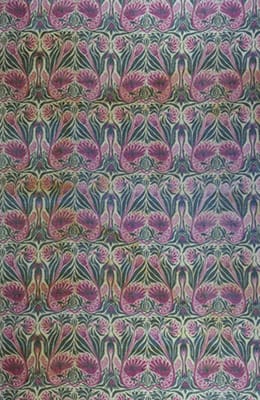
Peacock
Artists participating in the Arts and Crafts Movement believed that the objects they created should be useful as well as beautiful and this belief is highlighted in their designs for wallpapers and textiles. Peacock is a fabric design that features tightly-packed peacock and plant forms with the initials of the Century Guild cleverly integrated into the design. It was produced in a variety of color options, such as this vibrant green and purple, as well as a more muted orange, turquoise, and pink palette, and a palette of yellow ochre, light brown, and cream.
It was primarily from William Morris that Mackmurdo learned how to adapt complex three-dimensional natural forms into flat patterns and clear parallels can be drawn between this design and the textile and wallpaper designs of Morris. However, Mackmurdo took this concept further, also drawing inspiration from his scientific learning and interest in the natural world, as well as his personal collection of objects of Japanese and Chinese design.
As with many of his works of the 1880s, in this design, Mackmurdo anticipated the Art Nouveau style of the following decade through his use of sinuous lines and natural imagery. Other proto-Art Nouveau designs he created around this time include a wallpaper with a vertical swirling leaf design produced by manufacturers Jeffrey & Co., and a wallpaper design combining Regency stripes with inset roundels containing a floral motif of tulips.
Block-printed cotton - William Morris Gallery, Walthamstow, London, England
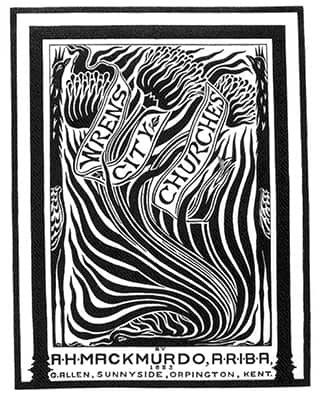
Wren's City Churches Cover
Mackmurdo was concerned with the conservation of historic buildings and had helped to found the Society for the Protection of Ancient Buildings in 1877. In 1883 he gave a lecture arguing in favor of the preservation of a number of churches by 17th-century English architect Sir Christopher Wren. Mackmurdo then published the lecture in a small campaign book titled Wren's City Churches. For the book cover, he created a bold black and white woodblock print featuring organic tendril forms in a whiplash motif with three stylized flower heads, very similar to the famous chair back he designed around the same time. This design was a key influence on the later graphic designs of Aubrey Beardsley, particularly his illustrations for Salome (1893), which are seen as seminal in the early development of Art Nouveau.
Architecture and design critic Edwin Heathcote explains that "The Victorians had enormous affection for Gothic cathedrals (which didn't stop them butchering them in the name of restoration) but less for the works of the English Baroque. Sir Christopher Wren's St Paul's Cathedral was widely admired but his City of London churches were losing their parishioners as it transformed from a dense urban centre with mixed uses into a dedicated business district. There were plans to demolish many and replace them with more useful buildings." Heathcote goes on to state that, although Mackmurdo's cover design for Wren's City Churches "was a radical, eccentric and beautiful design", it was, however, "a dreadful book, full of flowery, overwrought sentences (which he found a little embarrassing later in life). But his heart was in the right place". For example, Mackmurdo wrote in the book "The charmed wiles, and full power of beauty belonging to architecture are only to be shown to those who love all art for her own loveliness' sake, and to those who by pain and many pains have sought to discipline and culture their taste, for receipt of her favour and enjoyment of her gifts".
Tim Rodgers, Director of the Museum of Arts and Design in New York, asserts that Mackmurdo's title page for Wren's City Churches "exhibits complex relationships of positive and negative space, visual rhythms, and abstract forms based upon the natural growth of plants... By contorting the stalks into unnatural, whiplashed forms, Mackmurdo fuses the white, negative space between the dark forms into active components of the picture plane". He goes on to explain that, whereas William Morris' designs placed "a strongly defined, visually stable pattern on top of a colored background, thus emphasizing the foreground and neglecting the background", Mackmurdo treats background and foreground with equal importance. Additionally, while Morris often divided his designs "into symmetrical segments that align themselves along a vertical or horizontal axis", Mackmurdo's designs are more characterized by asymmetry, another key component of Art Nouveau and something he probably adopted from the Japanese compositions of which he was so fond. This is a clear example of Mackmurdo working with Morris' ideas and aesthetics but developing them further to create something beautiful and unique that bridges the gap between Arts and Crafts and later Modernism.
Woodcut on handmade paper - Dallas Museum of Art, Texas
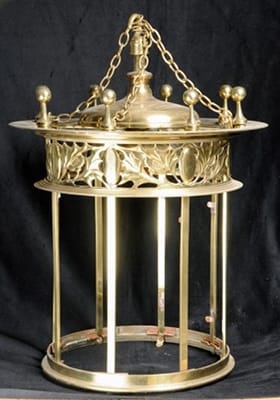
Hanging Lamp
Mackmurdo and the Century Guild offered design services for every aspect of a space, including the architecture, furniture, fabrics used for upholstery, wallpaper, and even light fixtures. This approach to designing an entire space as a cohesive whole is known as Gesamtkunstwerk, a German term that means "total work of art". This is an example of a hanging lamp by Mackmurdo. Elements of the design mimic the style of architecture he was known for, with simple, slender vertical columns emphasizing the horizontality of the piece. Near the top of the drum is an ornate band featuring organic plant forms (resembling thistle leaves). Such forms were commonplace across Mackmurdo's work, and in the works of the Arts and Crafts Movement more generally.
Although Mackmurdo was the designer, the lamp was made by George Esling, an associate of the guild, who specialized in copper, brass, and pewter work. This demonstrates the collaborative tenets of the guild and of the wider Arts and Crafts movement. The lamp was designed to be used with electric, rather than gas, lights. This decision marked Mackmurdo and the Century Guild as progressive and keen to adopt new technologies, which probably contributed to their success as well as pre-empting the technological aspects of Art Nouveau and, later, Art Deco.
Brass and glass - William Morris Gallery, Walthamstow, London
Brooklyn
Brooklyn was a house that Mackmurdo designed for his brother at 8 Private Road in Enfield. It is one of twelve family houses he designed in the course of his career and is characterized by a compact rectangular form, a flat roof, horizontal banding, and square columns. Architecture and design critic Edwin Heathcote writes that this "strikingly austere and stripped-back design...seems to predict 1920s Modernism and even streamlining and Art Deco". He notes that "The four small terracotta urchins [which stand above the horizontal banding on the second floor exterior] are the only indication that this is still sentimental Victorian England". There are also terracotta reliefs of fruit and flowers surrounding the ground-floor windows. The terracotta work was executed by Benjamin Creswick, who associated frequently with the Century Guild. Historian Peter Stansky writes that Brooklyn exudes "sophisticated classicism" and calls it "one of the most exciting houses of the nineteenth century". In February 1970, Brooklyn was listed as Grade II on the National Heritage List for England, meaning that it is "of special interest, warranting every effort to preserve it".
Mackmurdo's design for Brooklyn was also derived in large part from his social and economic reform work. As arts writer Claudia Pritchard explains, the house "was proudly costed at a mere £620. The figure was significant: to build a typical London terrace, poorly lit and ventilated, cost £600. Mackmurdo with his design showed that with an extra £20 and a lot of imagination it was possible to create a more spacious home". She adds that Brooklyn "had enough rooms for parents and children...Gaps between floorboards were sealed and there were few dust-gathering surfaces. The message was clear: here is a family home, and no servants are obliged to live in". Mackmurdo himself said that his aim was "to bring Architecture within the reach of all...nor is this very difficult, if in the first place the materials, selected with care, are treated in a workmanlike way, and if, in the second place, the proportions are made artistically valuable". In the case of Brooklyn, he said, "it has been the endeavour to introduce a certain dignity of treatment and interest of detail into a class of house which has been hitherto left to the suburban builder to run up as insufficiently and vulgarly as the genius of commercialism is able".
Elements of Brooklyn's design (particularly the columns and simple, flat, square capitals) were also present in a house Mackmurdo designed for Australian-British artist Mortimer Menpes, at 25 Cadogan Gardens, Chelsea, London (1893-94), as well as in a stand designed by the Century Guild for the Cope Brothers tobacco company, exhibited at the 1886 Liverpool International Exhibition. These designs went on to influence English architect and artist C.F.A. Voysey, and through him, Scottish architect Charles Rennie Mackintosh, particularly his design for the Glasgow School of Art Library (1909). Heathcote notes that Mackmurdo's simple architectural designs also had an influence on Modernist industrial architecture in general.
Enfield, England
Small oak writing desk
In his furniture design, as in his architectural work, Mackmurdo favored simple, clean lines, and was inspired by the plain, unornamented style of the Japanese. This small writing desk features tapered legs, brass knobs, and what arts and literature writer Keri Davies calls "emphatic horizontals". Art historian Aymer Vallance writes that, "To summarise Mr. Mackmurdo's design as a whole, if there is one leading quality which dominates all the rest it is that he consistently recognises proportion to be the fundamental....And next he values architectural severity of line in all structural features, whether be in metal work or in wood furniture".
Vallance goes on to note that, with this desk, "the artist has aimed accordingly at maintaining the sturdy character of the material in every part. The pronounced projections, intended to give distinct contrast of light and shade and to emphasise the construction, are features in this design...which have been followed by many a late designer exhibiting at the Arts and Crafts Society and elsewhere". Mackmurdo's approach to furniture design had a significant influence on later designs of Charles Rennie Mackintosh, such as his Chair for a Writing Desk for The Hill House (1904-05), whose shaft-like verticals and severe form strongly recall the furniture of Mackmurdo.
Oak and Brass - William Morris Gallery, Walthamstow, London, England
Biography of Arthur Heygate Mackmurdo
Childhood
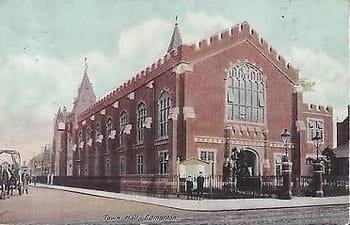
Arthur Heygate Mackmurdo was the eighth of ten children born to Edward and Anne Mackmurdo. His mother came from the Carte family of music publishers. The couple's first five children, none of whom survived into adulthood, were born when they were living in the Bermondsey district of southeast London. At the time, Bermondsey was the site of slum dwellings and heavy industrial plants. Author Charles Dickens described the area in Oliver Twist (1837), writing, "rooms so small, so filthy, so confined, that the air would seem to be too tainted even for the dirt and squalor which they shelter...dirt-besmeared walls and decaying foundations, every repulsive lineament of poverty, every loathsome indication of filth, rot, and garbage". In 1847, the Mackmurdos moved to the far more sanitary north London town of Edmonton.
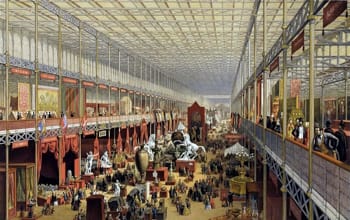
It was here in 1851 that Mackmurdo was born. This was the same year as the Great Exhibition of the Works of Industry of All Nations took place in London's Hyde Park (also known as the Great Exhibition or the Crystal Palace Exhibition). This was the first of a series of World Fairs that happened across Europe aiming to showcase new developments in culture and industry. Mackmurdo's father was a wealthy chemical manufacturer who was involved in the production of artists' materials and he exhibited these at the Great Exhibition two months before his son's birth.
Unbeknownst to the Mackmurdos, a young poet, artist, and social reformer named William Morris was in attendance at the Great Exhibition. The displays of mass-produced commodities, which German philosopher Karl Marx called the "emblem of the capitalist fetishism of commodities", inspired Morris to envision a future for British architecture and design that moved away from mass manufacturing and instead looked backwards in time to the medieval period for inspiration. A few decades later, Morris' and Mackmurdo's fates would converge.
Education and Early Training
After graduating from the Felsted boarding school in Dunmow, England, Mackmurdo began training under architect T. Chatfield Clarke, though he later stated that, at the end of his time with Chatfield Clarke, "I was as ignorant of architecture as when I entered this architect's office". In 1869, he started working as an assistant to Gothic Revival architect James Brookes.
Four years later Mackmurdo met writer, philosopher, and art critic John Ruskin at Ruskin's School of Drawing, and began attending his lectures. The two men found that they shared many of the same core beliefs and ideals (primarily, that artisanal craftsmanship was superior to new industrial means of production, not only aesthetically, but also as regards morality), and they grew close. In 1874, Mackmurdo accompanied Ruskin on a trip to Italy. He remained in Florence for some time after Ruskin had left, in order to study the city's Renaissance architecture. Later that same year, he opened his own architectural practice at 28 Southampton Street, in central London. Then, in 1877, he joined William Morris (one of Ruskin's most devoted followers, whom he had met through Ruskin) in helping found the Society for the Protection of Ancient Buildings, which sought to combat the rampant, careless, and often destructive Victorian-era restoration of historic buildings.
In addition to his studies in art and design, Mackmurdo stated that, during the 1870s, he educated himself extensively in "Social Statics and Social Dynamics" and "the positiv [sic] sciences...from Mathematics to Ethics, and from Astronomy to Sociology," with the assistance of Herbert Spencer, a family friend. Mackmurdo was particular enthralled by Charles Darwin's theories of evolution and natural selection. Spencer strongly encouraged Mackmurdo to further his studies in these areas by attending lectures given by biologist and anthropologist Thomas Huxley (who was sometimes referred to as "Darwin's bulldog", as he strongly advocated for Darwin's theories) and linguist William Tyndall. Mackmurdo also closely followed the work of French Positivist philosopher Auguste Comte, and referred to himself as a "staunch Positivist". In 1883 he lectured on Positivism at Newton Hall in Fetter Lane in London.
Mature Period
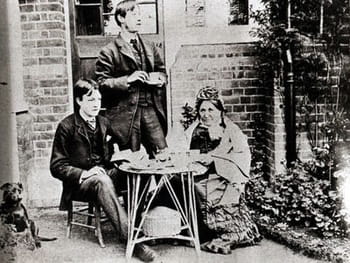
In 1882, Mackmurdo, along with his friend and architectural pupil Herbert Percy Horne, co-founded the Century Guild of Artists, which followed Ruskin's philosophies. Like Ruskin, Morris, and other pioneers of the Arts and Crafts Movement, the two men believed that art should be socially engaged, and that modern artist groups should thus model themselves upon medieval guilds and craft communities. Arts writer Claudia Pritchard notes that "Drawn together by a combination of art appreciation in its broadest sense, open-mindedness and concern for social reform, the Century Guild outriders rode a wave of exhibitions that, in the wake and in the manner of the Great Exhibition, showed alternative ways of living." As architecture and design critic Edwin Heathcote explains, "Guilds were everywhere in the late 19th century. There was Ruskin's Guild of St George, CR Ashbee's Guild and School of Handicrafts and the Art Workers' Guild, all left-leaning experiments in design, production, crafts and community... Mackmurdo's guild...set to work designing luxury objects, furnishings, fabrics and interiors for the restaurants, hotels and houses of wealthy businessmen and bohemian friends."
Mackmurdo, Ruskin, Morris, and others involved in the Arts and Crafts Movement, believed that art and design should be anti-elitist and utilitarian, and focused their energies on a wide array of decorative arts, as opposed to the "high arts" of painting and sculpture. They argued for making "all branches of art the sphere no longer of the tradesman but of the artist". For instance, Mackmurdo became adept at both metalworking and cabinet making, as well as textile, tapestry, and wallpaper design and production. They also believed that all elements of a space (architecture, decor, furniture, etc.) should follow a unified design plan, as per the concept of Gesamtkunstwerk. Another belief that all these artists shared was that the artist should be involved in all stages of the production process, as opposed to simply coming up with a design that would then be passed off to manufacturers. Tim Rodgers, Director of the Museum of Arts and Design in New York, notes that "Because work done at the guild was cooperative, one often finds disentangling individual contributions difficult. However, Mackmurdo's designs have a distinct style: a hybrid of Morris's Medieval Revival style and Art Nouveau."
Other artists who became members or associates of the Century Guild included Selwyn Image, Clement Heaton, William De Morgan, Heywood Sumner, Christopher Whall, Charles Winstanley, William Kellock Brown, George Esling, and Benjamin Creswick. The guild offered "complete furnishing" of homes and commercial buildings. For instance, at the 1884 Health Exhibition in London, the guild displayed a music room, for which they had designed and manufactured every element, from the decoration, to the fabrics, to the furniture, and even a piano designed by Mackmurdo himself. Pritchard notes that "Music was to be a strong partner in a movement [Arts and Crafts] that was at first glance design-led, but which also incorporated poetry and prose". The music room went on to be exhibited at other exhibitions in Manchester and Liverpool.
In 1884, Mackmurdo and the members of the Century Guild began publishing The Hobby Horse, the first "finely printed" magazine on art. As Heathcote explains, the publication served as "a way of communicating not only designs and ideas but an entire attitude to culture. It embraced art, literature, poetry, design, drawing and much else. With its elegant covers and quirky contents, it became an influential organ, notably in the US, where it inspired The Knight Errant, a journal in Boston, the editors of which - Ralph Adams Cram and Bertram Goodhue - were pivotal in the development of Gothic Revival architecture and early Art Deco. It also influenced Belgian architect Henry van der Velde, who, in an indirect way, was responsible for inspiring the Bauhaus." The first issue of the magazine featured a lecture on art by Selwyn Image, a laudatory article about the National Gallery (which, wrote Mackmurdo, housed "a collection finer than any in the world"), a music review, and more. A second issue included an essay on English poet John Keats by Irish poet and playwright Oscar Wilde, who was a friend of, and frequent visitor to, the guild. In fact, when Wilde was released from prison (after serving two years for "gross indecency with men") in May of 1897, he took up residence in a Bloomsbury home designed by Mackmurdo.
At most, The Hobby Horse only had a readership of about 200 or 300, and the publication was mainly financed by Mackmurdo, with his earnings from his architecture and design work. He soon grew tired of this financial demand that appeared to reap little reward, and in 1892, after seven volumes and twenty-eight issues, he stopped production of the magazine. That same year, the Century Guild dissolved, in part because Mackmurdo and Horne had a falling out, probably related to money. Indeed, Mackmurdo was known to be extremely careless with money, and not just his own. He reportedly lost a significant amount of money belonging to Selwyn Image, after talking him into investing in a scheme he thought was a sure thing. He also lost a part of his own fortune on a failed venture to develop a salt-water therapy hotel in Cheshire.
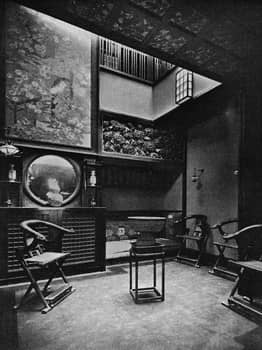
Around 1888, Mackmurdo was hired (presumably through his cousin, composer and hotelier Richard D'Oyly Carte, who built both the Savoy Hotel and Savoy theatre) to be the interior architect for the luxury Savoy Hotel in London, which was to open the following year. His design for the space is considered an early example of Art Nouveau interior design. Throughout the 1880s and 1890s, in addition to receiving architectural commissions in London and Manchester, he was also involved with the Home Arts and Industries Association and the Art for Schools Association.
Late Period and Death
In 1902, when he was fifty years old, Mackmurdo married his cousin from his mother's side, Eliza D'Oyly Carte, who was nine years his junior. The couple moved to Essex, where Mackmurdo began construction on a large house, called Great Ruffins, which they intended to occupy. His plans for the house included a large observatory tower, from which he could pursue his interest in astronomy. Unfortunately, when the house was near completion, Mackmurdo was forced to sell it due to a lack of finances. He had been relying on his wife's fortune to fund the construction, until her brother Geoffrey approached him and informed him that her money was held in trust and was not liquid for him to spend on frivolities. The couple moved instead to a small home nearby (called Little Ruffins), though the ever-charming Mackmurdo sometimes persuaded the new owner of Great Ruffins to allow him to host large parties there.
It was around this time that Mackmurdo began to feel "more and more...an influence drawing me aside from architecture and planning of buildings to study problems connected with the Social Structure". In 1906 he retired completely from art and architecture, and focused the entirety of his energies on social and economic reform. Some years later, he stated "Since I retired from professional work I have concentrated upon the study of Social events in the old & the new world, pondering over them with a view to formulating if possible some Social Synthesis which would be consistent with what we know of the process of Evolution in the organic world".
Mackmurdo's social reform work focused on electoral reform, and on fighting for living wages and pensions fixed by the state. More impractically, he also argued in favor of replacing the gold standard with a system based on food vouchers. He wrote several socialist pamphlets, and in 1926, he published the book The Human Hive: Its Life and Law. In 1929 he helped establish the Rural Community Council of Essex, "an independent charity working to help rural communities achieve a thriving and sustainable future [by addressing] issues such as social isolation, poor access to services and a shortage of affordable housing".
Mackmurdo passed away at the age of ninety-one, at his bungalow in Essex. While still alive, he had donated many of his own works, and pieces by other members of the Century Guild, to the William Morris Gallery in Walthamstow, and to museums in Colchester and Ipswich. These donations also included objects from his personal collection, which provide greater insight into his varied inspirations, such as several copies of paintings by Renaissance masters, as well as Chinese and Italian textiles, with some dating as far back as the 16th century.
The Legacy of Arthur Heygate Mackmurdo
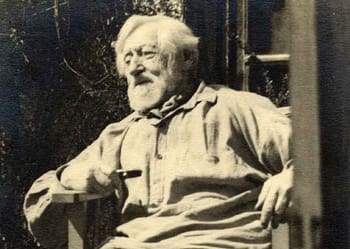
Though little known today, Arthur Heygate Mackmurdo's contributions to modern art and architecture are significant. Not only were his designs leading examples of the core philosophies of the Arts and Crafts Movement, they also anticipated Art Nouveau, particularly in terms of the use of asymmetrical, organic, and whiplash motifs, by a full decade. The work he produced independently, and in collaboration with other members of the Century Guild, were particularly influential on artists and architects C.F.A. Voysey and Charles Rennie Mackintosh in the United Kingdom, as well as Henry van der Velde and Victor Horta in Belgium, and Hector Guimard in France. Later movements, including Art Deco and much modern architecture can trace their roots back to Mackmurdo and the Century Guild.
Arts writer Claudia Pritchard asserts that "The Arts and Crafts movement provided a bridge from tradition and nostalgia to the modernism that was to follow. Few of its leading lights display this shift as sumptuously as Arthur Heygate Mackmurdo. Between the Arts and Crafts pioneering work of William Morris and the lean soaring lines with floral motifs of Charles Rennie Mackintosh, a third and influential "M" helped define the look of late Victorian and Edwardian Britain, and influence style at home and abroad". Likewise, the hard-to-please art historian Nikolaus Pevsner went so far as to argue that "Some of [Mackmurdo's] works between 1880 and 1890 were more adventurous than those of any other British architect during that decade. Which is tantamount to saying the work of any European architect."
Mackmurdo further influenced art, design, and architecture through his social and economic reform work, particularly in the way he sought economical design solutions that would permit all people, not just the upper classes, to live in well-lit, well-ventilated, and sufficiently spacious homes. Arts and literature writer Keri Davies explains that "Mackmurdo was one of the first in England to think about regional planning and garden cities". In a similar vein, architecture and design critic Edwin Heathcote notes that Mackmurdo's "social impulses - for preservation, the dignity of labour and culture as a political as well as an artistic project - look as modern as his finest designs", and asks us to consider "whether Mackmurdo's notion of the past - and of preservation, architecture and the pastoral - wasn't his true contribution to the modern. After all, what could be more contemporary than heritage and ecology?"
Influences and Connections

-
![John Ruskin]() John Ruskin
John Ruskin -
![William Morris]() William Morris
William Morris - James Brooks
-
![Oscar Wilde]() Oscar Wilde
Oscar Wilde - Herbert Percy Horne
- Selwyn Image
- Benjamin Creswick
- Clement Heaton
-
![Charles Rennie Mackintosh]() Charles Rennie Mackintosh
Charles Rennie Mackintosh -
![Hector Guimard]() Hector Guimard
Hector Guimard -
![Victor Horta]() Victor Horta
Victor Horta ![Henry van de Velde]() Henry van de Velde
Henry van de Velde- Charles Francis Annesley Voysey
-
![Oscar Wilde]() Oscar Wilde
Oscar Wilde - Herbert Percy Horne
- Selwyn Image
- Benjamin Creswick
- Clement Heaton
Useful Resources on Arthur Heygate Mackmurdo
- The Century Guild Hobby Horse; Volume 1Our Pick
- The Human Hive: Its Life and Law
- Wren's City ChurchesOur Pick
 Ask The Art Story AI
Ask The Art Story AI













